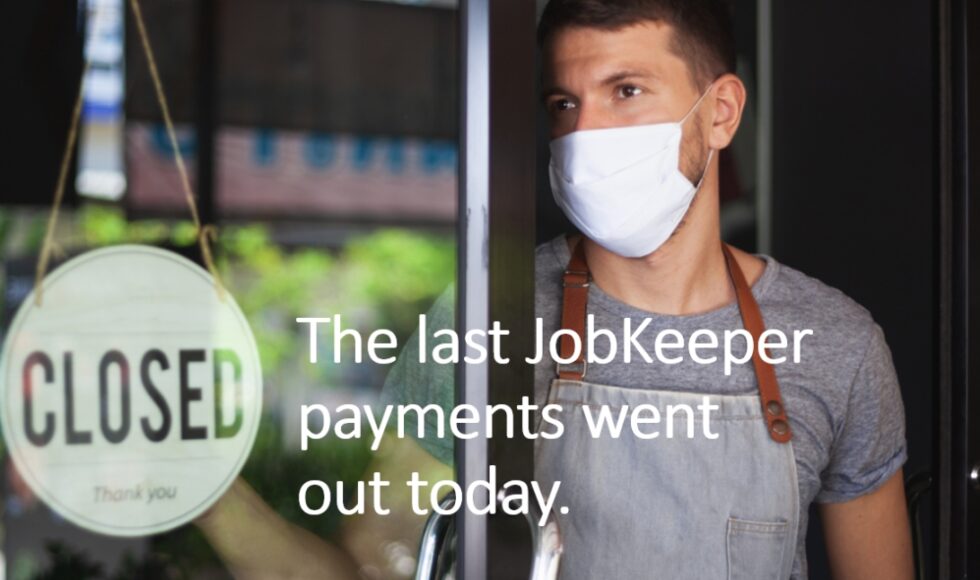The final payments under the JobKeeper program are being processed today, but the full impact of its removal will remain unclear for some time given the lag in economic data getting reported. We will look at real-time data from lenders to see the impact as it unfolds.
The JobKeeper program is the biggest government stimulus programme that has ever been undertaken on our shores. How will the Australian economy respond as this stimulus is removed? Depending on which economist you ask, there might be 60,000 workers laid off, others think there might be 280,000. Treasury tell us their best guess is 150,000.
When COVID first hit, as well as the fear, we felt uncertainty. Everything was hard to quantify so when the GDP figures for the June ’20 quarter were released on September 2nd, we remember hitting refresh as the figures become public. -7%! The largest quarterly drop in GDP in our nation’s history.
But it was academic. By that point, on September 2nd, we already knew the recovery was well and truly occurring. How? Because we were fortunate enough to get access to up-to-date data from lenders who we finance – who provide us with constant feedback about how the real economy was performing.
Lenders get real-time insight into how “main street” businesses and consumers are coping in the real economy. If they are prudent, they have a well-diversified loan portfolio that allows them to see how the broader economy is working. If they are more specialised, they give us an opportunity to see the impact on niches of the market.
GCI finance smaller commercial lenders across a broad spectrum of products including term loans, leasing, invoice finance and equipment finance. We also finance a number of consumer lenders who offer personal loans and Buy Now Pay Later plans.
As COVID played out, some banks circulated research showing how short-term indicators might suggest broad market trends, but as an investor, one always has to be wary of what data they are sharing and what they’re keeping proprietary.
What we saw from the portfolio of lenders we were funding was a story that played out in three phases:
- Phase one – a massive increase in arrears and hardship applications from our lenders who operate in the SME market, which prompted some borrowers operating in that market to reach out to us and say – “we’re going to cease new originations for a period, are you happy to support us in that?”. Of course we said yes.
- Phase two – our consumer lending clients saw remarkable robustness in their portfolios, indicating that government support was doing what it intended to. We saw consumer delinquencies below pre-COVID levels as JobKeeper rolled out.
- Phase three – by August, even businesses that had thought they were in distress had started to cure and wanted to live up to their obligations once again. Our portfolio of SME lenders were coming to us and saying “We want to lend again, will you support us?” We looked at their data, and once again, of course, said yes.
So how are we looking at the removal of JobKeeper? What insights are we going to be looking for to inform our investment perspective before we get the long lagging official data?
Our thesis is that the removal of JobKeeper is obviously going to have an impact, but we think it is going to show itself progressively, through the following forms:
A material number of people are going to lose their jobs – in the order of tens to hundreds of thousands
- We expect the effect of this to be minimal because everyone has seen this coming (both employees who were only kept on due to their marginal worth as a result of the subsidy and employers not wanting to appear callous for removing employees once the subsidy subsided even though its removal was well flagged).
The removal of massive cash transfers to SMEs
- While this was known and quantifiable in advance, we believe many marginal businesses will have been “holding on”, and without government assistance, marginal businesses will be forced into failure.
The real impact of these points will be hard to assess as we balance the economy organically recovering (positive impact) in conjunction with JobKeeper being removed (negative impact). While overall we are optimistic that this will play out positively, we will be using data from lending companies to help us form an early view on the real state of play. Here’s what we’ll be looking for:
1. In consumer portfolios, early arrears. One area to watch will be Buy Now Pay Later plans which are heavily skewed to a younger demographic.
2. In loans made to small businesses, distress in loans which were previously showing challenges, particularly those:
- originated prior to the original COVID outbreak and were subsequently restructured or modified (e.g. by extending the term of the loan)
- extended to borrowers in particularly COVID-exposed industries (e.g. travel/accommodation, retail trade etc.)
- extended to borrowers which are more highly leveraged (as indicated by higher interest rates on the loans)
We will be following this closely over the coming weeks and as we uncover valuable insights, we hope to share them with you.
Authored by Henry Stewart (Director), Jacob Rosenberg (Investment Director) at Global Credit Investments (gcifunds.com).

